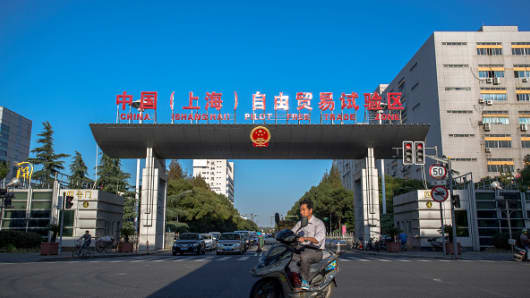14 December 2014
Jamil Anderlini
Financial Times
China will create three new free trade zones modeled on one established a year ago in Shanghai as the government tries to support lackluster trade and boost slowing growth in the world’s second-largest economy.
The three new zones will be established in the southern and eastern provinces of Guangdong and Fujian and in the northern port city of Tianjin, China’s State Council said in a statement.
Shanghai’s free trade zone, or FTZ, which opened in September 2013, was heralded as a laboratory for ambitious free market reforms that would lift everything from financial and currency restrictions to administrative controls on foreign investment.
But investors have been mostly disappointed by progress in the zone and say it provides almost no advantages for foreign or domestic companies operating there.
The three new zones will be established in the southern and eastern provinces of Guangdong and Fujian and in the northern port city of Tianjin, China’s State Council said in a statement.
Shanghai’s free trade zone, or FTZ, which opened in September 2013, was heralded as a laboratory for ambitious free market reforms that would lift everything from financial and currency restrictions to administrative controls on foreign investment.
But investors have been mostly disappointed by progress in the zone and say it provides almost no advantages for foreign or domestic companies operating there.
There are virtually no business or investment activities permitted in the Shanghai zone that are not also allowed in the rest of China and the reforms that have been announced so far have been tiny and incremental.
The Shanghai zone has also faced opposition from local officials, as well as some ministries in charge of financial and economic oversight and has also already been affected by an alleged corruption scandal that saw the removal of one of its most senior officials.
In a statement announcing the three new zones, the State Council, China’s cabinet, also promised more experimentation would be conducted within the existing Shanghai FTZ to encourage foreign investment and the development of advanced manufacturing and the service sectors.
The new zones will be based on the Shanghai model but will also include “local characteristics” the statement said.
“Following the success of the pilot free trade zone in Shanghai, new parks will be opened in Tianjin, Guangdong and Fujian,” the statement said.
The Guangdong zone in southern China is expected to include Hong Kong and Macau, as part of the government’s efforts to accelerate their integration into the mainland.
The Shanghai zone has also faced opposition from local officials, as well as some ministries in charge of financial and economic oversight and has also already been affected by an alleged corruption scandal that saw the removal of one of its most senior officials.
In a statement announcing the three new zones, the State Council, China’s cabinet, also promised more experimentation would be conducted within the existing Shanghai FTZ to encourage foreign investment and the development of advanced manufacturing and the service sectors.
The new zones will be based on the Shanghai model but will also include “local characteristics” the statement said.
“Following the success of the pilot free trade zone in Shanghai, new parks will be opened in Tianjin, Guangdong and Fujian,” the statement said.
The Guangdong zone in southern China is expected to include Hong Kong and Macau, as part of the government’s efforts to accelerate their integration into the mainland.
Beijing is also hoping the zones will push manufacturers into upgrading from the low-end manufacturing that made China an export powerhouse over the last two decades.
Growth in Chinese trade has been lacklustre for the last year and has slumped in recent months, causing concern among policymakers who are also confronted with a sharp slowdown in domestic real estate and serious overcapacity throughout the industrial sector.
China is on track to post its slowest annual growth rate in 25 years this year and Beijing sees boosting trade and exports as the simplest and most effective way of stopping growth from falling further.
Officials have recently discussed the possibility of setting up more FTZs in countries in Southeast and Central Asia along what Beijing has dubbed the “21st Century Silk Road Economic Belt and Maritime Silk Road” trade routes between China and Europe.

Courtesy of the Financial Times
Growth in Chinese trade has been lacklustre for the last year and has slumped in recent months, causing concern among policymakers who are also confronted with a sharp slowdown in domestic real estate and serious overcapacity throughout the industrial sector.
China is on track to post its slowest annual growth rate in 25 years this year and Beijing sees boosting trade and exports as the simplest and most effective way of stopping growth from falling further.
Officials have recently discussed the possibility of setting up more FTZs in countries in Southeast and Central Asia along what Beijing has dubbed the “21st Century Silk Road Economic Belt and Maritime Silk Road” trade routes between China and Europe.

Courtesy of the Financial Times
